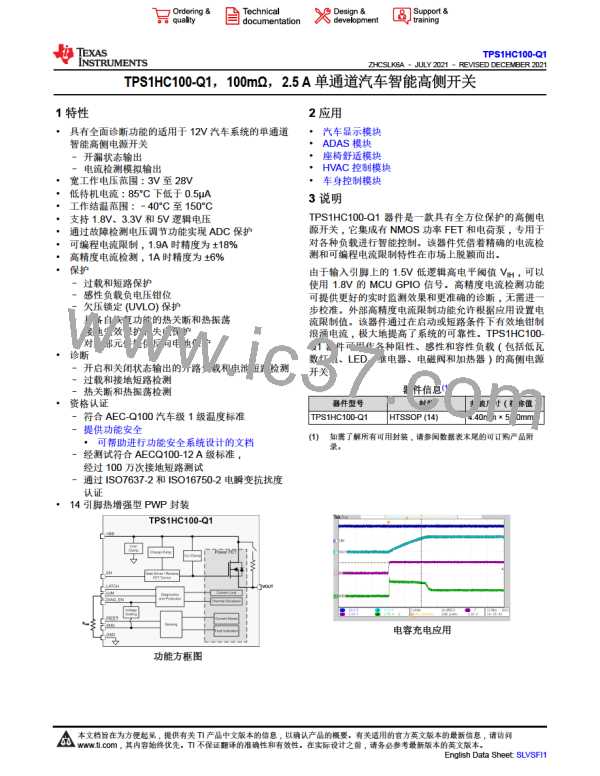TPS1HC100-Q1
ZHCSLK6A –JULY 2021 –REVISED DECEMBER 2021
www.ti.com.cn
8.3.4.5 Latch-Off Mode
The TPS1HC100-Q1 comes with a latch functionality that decides after the channel is shut down due to a fault,
whether or not to automatically try and turn back on, or stay off until other action is taken. This action is done by
holding the LATCH pin high for latch-off functionality or holding LATCH low for auto-retry functionality.
The order that occurs is:
1. Device shuts down due to fault (relative thermal shutdown)
2. Wait tRETRY
3. If LATCH = 0
a. Turn back on the channel
4. If LATCH = 1
a. Keep off until LATCH = 0 || EN = 0
i. Then if LATCH = 0 and EN = 1
1. Turn on channel into auto-retry mode
ii. If LATCH = 1 and EN = 1
1. Turn on channel into latch mode where if another fault occurs then output is latched off again
For more information, see Thermal Protection Behavior.
8.3.4.6 Thermal Protection Behavior
The thermal protection behavior can be split up into three categories of events that can happen. 图 8-16 shows
each of these categories.
1. Relative thermal shutdown: the device is enabled into an overcurrent event. The DIAG_EN pin is high so
that diagnostics can be monitored on SNS and FLT (however, DIAG_EN being high is not necessary for all
protection features to function). The output current rises up to the IILIM level and the FLT goes low while the
SNS goes to VSNSFH. With this large amount of current going through the junction temperature of the FET
increases rapidly with respect to the controller temperature. When the power FET temperature rises TREL
amount above the controller junction temperature ΔT = TFET –TCON > TREL, the device shuts down. The
faults are continually shown on SNS and FLT and the part waits for the tRETRY timer to expire. When tRETRY
timer expires, because the LATCH pin is low and EN is still high, the device comes back on into this IILIM
condition.
2. Absolute thermal shutdown: the device is still enabled in an overcurrent event with DIAG_EN high and
LATCH still low. However, in this case the junction temperature rises up and hits an absolute reference
temperature, TABS, and then shuts down. The device does not recover until both TJ < TABS –Thys and the
tRETRY timer has expired.
3. Latch-off mode: the device is enabled into an overcurrent event. The DIAG_EN pin is high so that
diagnostics can be monitored on SNS and FLT. The output current rises up to the IILIM level and the FLT
goes low while the SNS goes to VSNSFH. If the part shuts down due to a thermal fault, either relative thermal
shutdown or absolute thermal shutdown, the device does not enable the channel until either the LATCH pin
or the EN pin is toggled.
Copyright © 2022 Texas Instruments Incorporated
Submit Document Feedback
31
Product Folder Links: TPS1HC100-Q1

 TI [ TEXAS INSTRUMENTS ]
TI [ TEXAS INSTRUMENTS ]